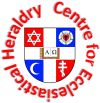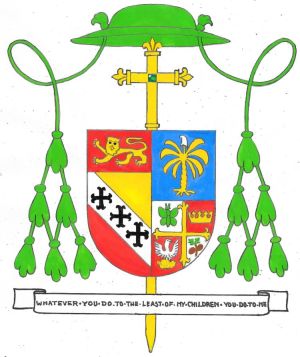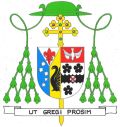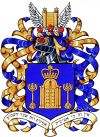Jacques Eric Fabre-Jeune: Difference between revisions
Knorrepoes (talk | contribs) m (Text replacement - "{{media}} Literature :" to "'''Literature''': {{media}}") |
Knorrepoes (talk | contribs) m (Text replacement - "↵{{media}}" to " {{rel}} {{media1}}") |
||
| Line 32: | Line 32: | ||
[[Heraldic literature - Ecclesiastical heraldry|'''Literature''']]: | [[Heraldic literature - Ecclesiastical heraldry|'''Literature''']]: | ||
{{ | {{rel}} | ||
{{media1}} https://charlestondiocese.org/bishop-jacques-fabre-jeune-cs/coat-of-arms/ | |||
[[Category:Roman Catholic bishops|Fabre-Jeune]] | [[Category:Roman Catholic bishops|Fabre-Jeune]] | ||
Revision as of 12:19, 26 December 2022
Religious or Ecclesiastical heraldry portal
This page is part of the Ecclesiastical heraldry portal |
Heraldry of the World |
|
Catholic heraldry
|
Other Christian churches Other religions
|
JACQUES ERIC FABRE-JEUNE
Born : November 13, 1955
Deceased :
Bishop of Charleston, 2022-present
Official blazon
===Origin/meaning===As common in US episcopal heraldry, the arms show the arms of the diocese impaled with the personal arms of the bishop.
The arms are a statement of faith and heritage, both of which have their beginnings in his birthplace, Port-au-Prince, the capital city of the Republic of Haiti. The overall colors of azure (blue), gules (red), and argent (silver) speak of life in Haiti and the United States. The shield is divided in half as per the flag of Haiti.
The upper portion contains a Royal Palm Tree in gold with a Phrygian cap in gold and silver. The palm tree was the first and most important emblem requested by Bishop Fabre-Jeune. It is a symbol of his place of birth and heritage, plus a symbol of the faith so deeply rooted within the Fabre family. This particular palm tree has eight branches, one for each member of the Fabre family: Bishop Jacques, his parents and his five siblings. The strong roots of the Royal Palm Tree are clearly visible, reaching out to the tip of the Cross Fleury.
The lower half of the shield is subdivided quarterly, silver and red. The first quarter contains a green Butterfly, a symbol for migration. The island of Hispaniola is home to one of the species of this migratory monarch butterfly. The use of green is associated with new life.
The second quarter features a Gold Crown borrowed from the coat of arms of the Scalabrinians — the Congregation of the Missionaries of St. Charles Borromeo — an international community of religious serving migrants and refugees of different cultures, religions and ethnicities. Bishop Fabre-Jeune is a professed member of this community.
The third quarter contains a Phoenix rising from the flames: a mythical bird that rejuvenates itself by dying in fire and being reborn from the ashes, a symbol of eternal life. The phoenix is from the coat of arms of the city of Chicago, where Jacques Fabre-Jeune professed first vows as a Scalabrinian in 1982.
The fourth quarter contains a Fig Bough with Fruit, representing the Old Testament prophet Amos. Before responding to the call of the Lord, Amos was “a herdsman, and a dresser of sycamore-fig trees” (7:14).
The lower portion of the shield contains a Cross Fleury over all with a fleur-de-lis at the end of each arm. The fleur-de-lis represents a lily, which is commonly associated with the Virgin Mary. In the story of our salvation, Mary is the first of those called to serve the Lord. The use of the cross is also a nod to the first Bishop of Charleston, John England (1820-1842), whose coat of arms featured a Cross Bottony over all.
The achievement is completed with the heraldic insignia of a prelate of the rank of bishop.
This page is part of the Ecclesiastical heraldry portal
|
Catholic heraldry
|
Other Christian churches |
|
Template:Media1 https://charlestondiocese.org/bishop-jacques-fabre-jeune-cs/coat-of-arms/






